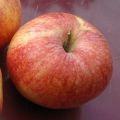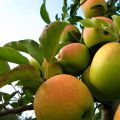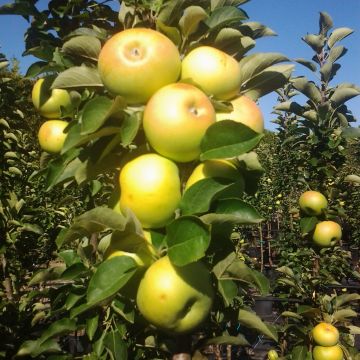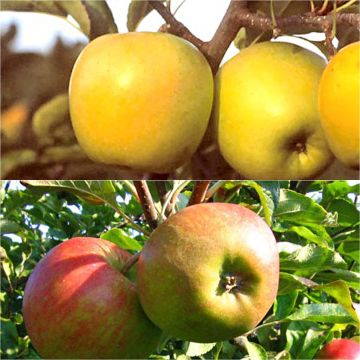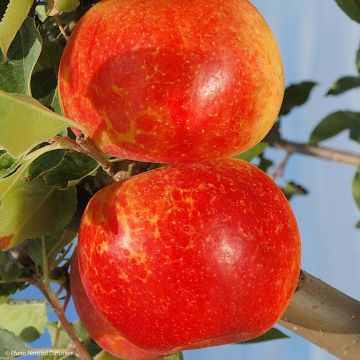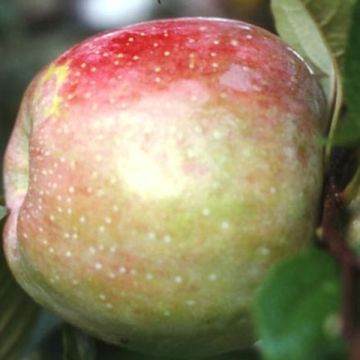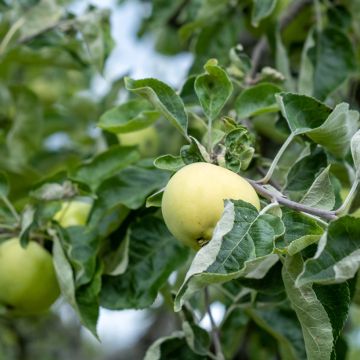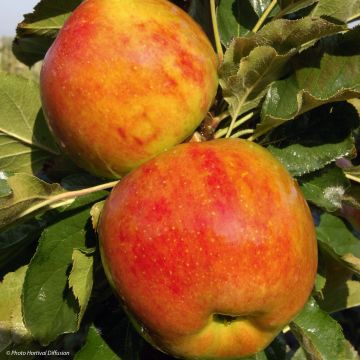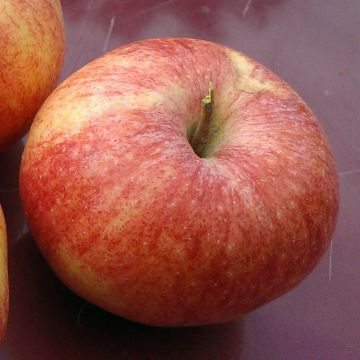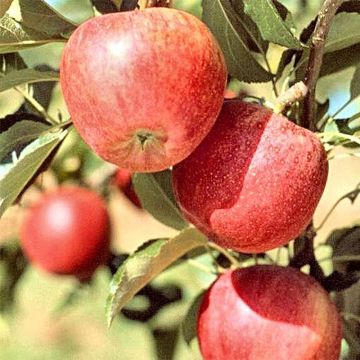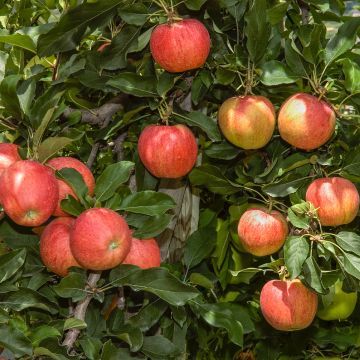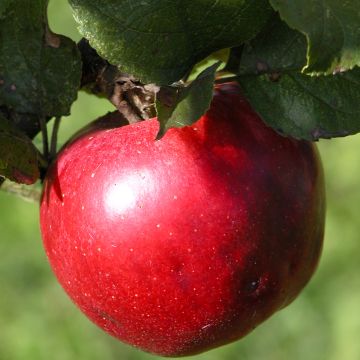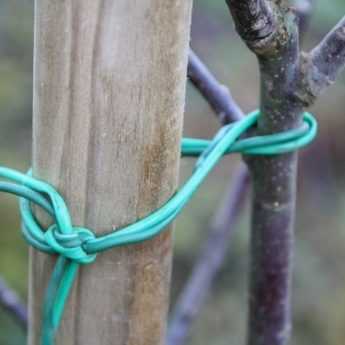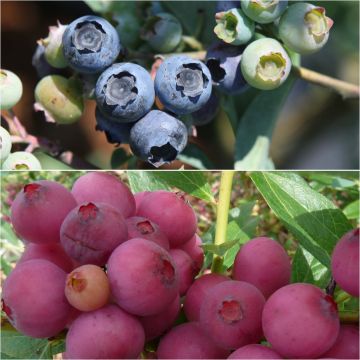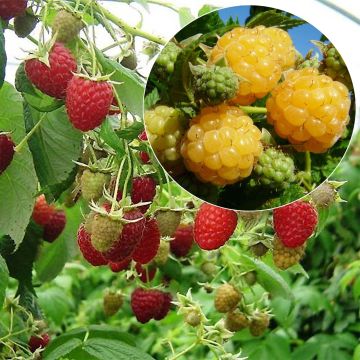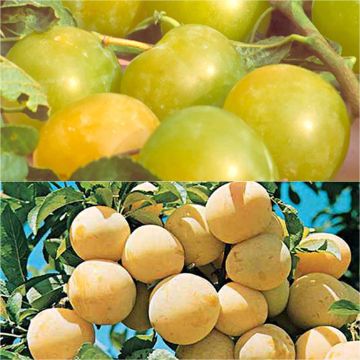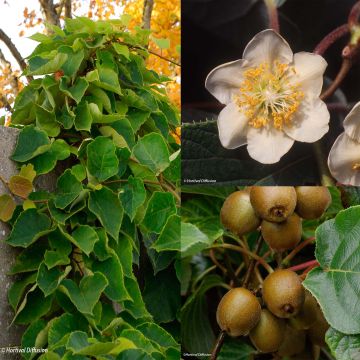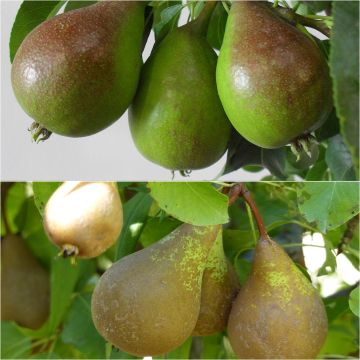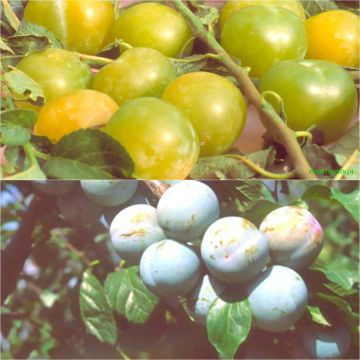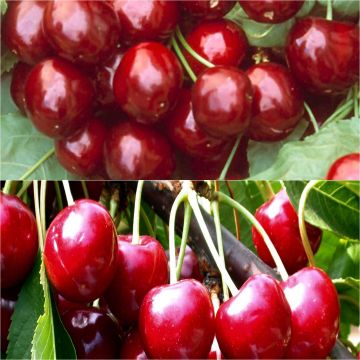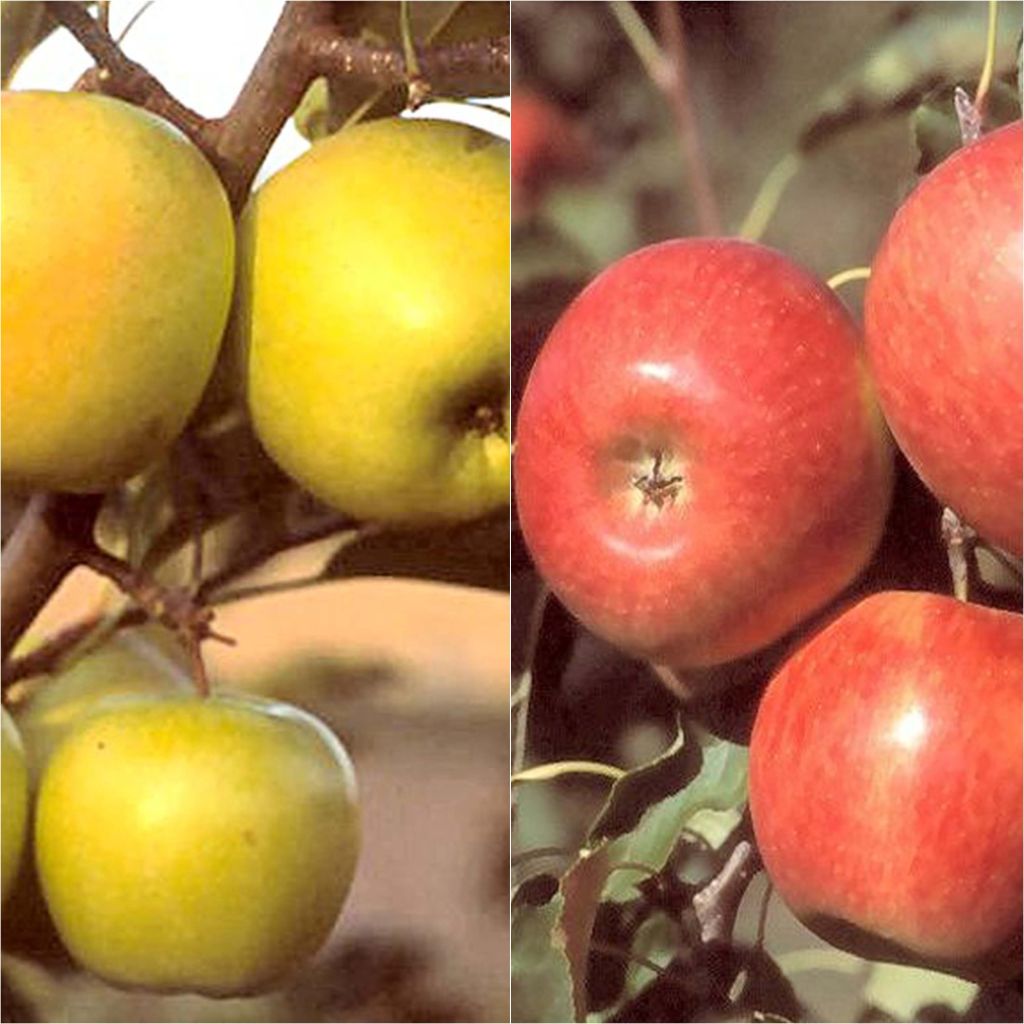

Reliable pollinator duo for Organic Apple trees
Reliable pollinator duo for Organic Apple trees
Malus domestica Golden Delicious, Reine des Reinettes
This plant carries a 6 months recovery warranty
More information
We guarantee the quality of our plants for a full growing cycle, and will replace at our expense any plant that fails to recover under normal climatic and planting conditions.
Collection items (2 plants)
-
Malus domestica Golden Delicious - Golden Delicious Apple
Price per single item: €34.50Find out more
Description
This self-fertile duo of organic apple pollinators brings together the varieties 'Golden Delicious' and 'Queen of the Pippins' that have proven themselves. Planted in the same garden, these two apple trees that bloom together in spring pollinate each other, ensuring a bountiful harvest in September-October. Bare-root fruit trees should be planted upon receipt, preferably in autumn.
This duo consists of:
-x1 Organic 'Golden Delicious' Apple Tree: extensively cultivated in France, this variety is the most well-known for apple lovers. The tree has medium vigor, quickly bears fruit, and offers a significant and regular yield. It produces large, uniformly golden yellow-skinned fruits with a conical shape. The pale yellow flesh is firm, fine, crisp, fragrant, and balanced between sweetness and acidity. Flowering usually occurs at the end of April, often avoiding frost, and the fruits are harvested in mid-September while still green. Golden apples can be stored until February in a cool place, although they tend to become slightly mealy. This apple tree is not self-fertile. It is easy to grow in all regions and has good frost resistance.
-x1 Organic 'Queen of the Pippins' Apple Tree: a vigorous and productive variety, highly resistant to cold and diseases. Highly appreciated in pastry, it is the deliciously tart and fragrant apple that made the famous Tarte Tatin a success. The fruits, about 7 cm (3in) in diameter, are covered with a red-yellow golden skin. The flesh is pale, juicy, fine, and crisp, both sweet and tart, with a hint of walnut that makes it irresistible. Harvest begins at the start of ripeness, in early September, and continues until October. 'Queen of the Pippins' apples store very well after harvest and can be consumed throughout the winter, until March. It will be necessary to thin them out to avoid small fruit size and the occurrence of diseases. This apple tree is an excellent pollinator.
Labelled separately
The apple tree is native to Europe, particularly in France where its presence has been documented since antiquity. It is a semi-erect, elegant tree. Its deciduous foliage falls in autumn. The leaves are very large, oval, slightly fuzzy, dark green on top and whitish green underneath, deeply toothed. Flowering occurs in April and is not affected by frost. The apple tree is therefore suitable for cultivation in mountainous regions.
'Golden Delicious' and 'Queen of the Pippins' apples can be enjoyed fresh, as well as in compotes, jams, pastries, and savory dishes, paired with Normandy cheeses, for example.
Designed for organic cultivation, the Organic Apple Tree will thrive under certain conditions. To avoid diseases and pests, the following measures should be taken:
- Space the trees 5 metres (16 feet) apart in all directions,
- Choose a deep, light, rich, and well-draining soil,
- Avoid planting on a site that previously hosted other woody plants, especially those of the same species,
- Prune to promote tree ventilation,
- Thin out to prevent the development of diseases on the fruits,
- Apply compost twice: during flowering and after harvest. The amount of compost should be adjusted according to the quality of your soil: the lower its organic matter content, the greater the amount needed,
- Install multi-species hedges (except for Malus species), stone and wood piles, and nest boxes (for birds, voles, and bats) to attract beneficial insects.
In case of disease outbreak, it will be necessary to remove and burn the affected parts. The Organic 'Queen of the Pippins' Apple Tree is resistant to diseases, but is somewhat susceptible to scab. If necessary, treat with Bordeaux mixture, using half the recommended dosage.
For transportation reasons, our tallest scions may be pruned before shipment. They are suitable for all common training systems except for high standards: cordons, espaliers, bush, half-standard. If you would like more information or advice on training your fruit trees, please do not hesitate to contact us.
Report an error about the product description
Plant habit
Fruit
Flowering
Foliage
Botanical data
Malus
domestica
Golden Delicious, Reine des Reinettes
Rosaceae
Cultivar or hybrid
Other Apple trees
View all →Planting and care
Choose a sunny location for your Organic Apple Tree, the soil can be slightly chalky or acidic but not excessively. Dig a large planting hole at least 3 times the size of the root ball. Simultaneously add organic matter (topsoil, compost) and a basal fertilizer such as crushed horn. Do not bury the graft collar. Stake if necessary. Water abundantly, even in winter, even if it rains. Fruit trees are ideally planted between October and March, outside the freezing period. Container-grown plants can be planted all year round except during periods of high heat or frost.
You can add a small handful of wood ash, rich in potash, during winter, this will improve fruiting. Watch out for potential aphid attacks during the season. A white powdery mildew caused by a fungus, powdery mildew, may appear on the leaves in summer, but it does not harm fruit development in gardens. Harvest takes place in September. Only keep the harvested fruits. Apples should be stored with the stem facing down on shelves or crates. Choose a preferably completely dark, dry and cool place, but frost-free.
Planting period
Intended location
Care
Planting & care advice
This item has not been reviewed yet - be the first to leave a review about it.
Similar products
Haven't found what you were looking for?
Hardiness is the lowest winter temperature a plant can endure without suffering serious damage or even dying. However, hardiness is affected by location (a sheltered area, such as a patio), protection (winter cover) and soil type (hardiness is improved by well-drained soil).

Photo Sharing Terms & Conditions
In order to encourage gardeners to interact and share their experiences, Promesse de fleurs offers various media enabling content to be uploaded onto its Site - in particular via the ‘Photo sharing’ module.
The User agrees to refrain from:
- Posting any content that is illegal, prejudicial, insulting, racist, inciteful to hatred, revisionist, contrary to public decency, that infringes on privacy or on the privacy rights of third parties, in particular the publicity rights of persons and goods, intellectual property rights, or the right to privacy.
- Submitting content on behalf of a third party;
- Impersonate the identity of a third party and/or publish any personal information about a third party;
In general, the User undertakes to refrain from any unethical behaviour.
All Content (in particular text, comments, files, images, photos, videos, creative works, etc.), which may be subject to property or intellectual property rights, image or other private rights, shall remain the property of the User, subject to the limited rights granted by the terms of the licence granted by Promesse de fleurs as stated below. Users are at liberty to publish or not to publish such Content on the Site, notably via the ‘Photo Sharing’ facility, and accept that this Content shall be made public and freely accessible, notably on the Internet.
Users further acknowledge, undertake to have ,and guarantee that they hold all necessary rights and permissions to publish such material on the Site, in particular with regard to the legislation in force pertaining to any privacy, property, intellectual property, image, or contractual rights, or rights of any other nature. By publishing such Content on the Site, Users acknowledge accepting full liability as publishers of the Content within the meaning of the law, and grant Promesse de fleurs, free of charge, an inclusive, worldwide licence for the said Content for the entire duration of its publication, including all reproduction, representation, up/downloading, displaying, performing, transmission, and storage rights.
Users also grant permission for their name to be linked to the Content and accept that this link may not always be made available.
By engaging in posting material, Users consent to their Content becoming automatically accessible on the Internet, in particular on other sites and/or blogs and/or web pages of the Promesse de fleurs site, including in particular social pages and the Promesse de fleurs catalogue.
Users may secure the removal of entrusted content free of charge by issuing a simple request via our contact form.
The flowering period indicated on our website applies to countries and regions located in USDA zone 8 (France, the United Kingdom, Ireland, the Netherlands, etc.)
It will vary according to where you live:
- In zones 9 to 10 (Italy, Spain, Greece, etc.), flowering will occur about 2 to 4 weeks earlier.
- In zones 6 to 7 (Germany, Poland, Slovenia, and lower mountainous regions), flowering will be delayed by 2 to 3 weeks.
- In zone 5 (Central Europe, Scandinavia), blooming will be delayed by 3 to 5 weeks.
In temperate climates, pruning of spring-flowering shrubs (forsythia, spireas, etc.) should be done just after flowering.
Pruning of summer-flowering shrubs (Indian Lilac, Perovskia, etc.) can be done in winter or spring.
In cold regions as well as with frost-sensitive plants, avoid pruning too early when severe frosts may still occur.
The planting period indicated on our website applies to countries and regions located in USDA zone 8 (France, United Kingdom, Ireland, Netherlands).
It will vary according to where you live:
- In Mediterranean zones (Marseille, Madrid, Milan, etc.), autumn and winter are the best planting periods.
- In continental zones (Strasbourg, Munich, Vienna, etc.), delay planting by 2 to 3 weeks in spring and bring it forward by 2 to 4 weeks in autumn.
- In mountainous regions (the Alps, Pyrenees, Carpathians, etc.), it is best to plant in late spring (May-June) or late summer (August-September).
The harvesting period indicated on our website applies to countries and regions in USDA zone 8 (France, England, Ireland, the Netherlands).
In colder areas (Scandinavia, Poland, Austria...) fruit and vegetable harvests are likely to be delayed by 3-4 weeks.
In warmer areas (Italy, Spain, Greece, etc.), harvesting will probably take place earlier, depending on weather conditions.
The sowing periods indicated on our website apply to countries and regions within USDA Zone 8 (France, UK, Ireland, Netherlands).
In colder areas (Scandinavia, Poland, Austria...), delay any outdoor sowing by 3-4 weeks, or sow under glass.
In warmer climes (Italy, Spain, Greece, etc.), bring outdoor sowing forward by a few weeks.



































